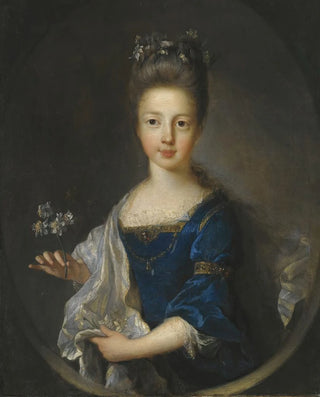Art print | Portrait of Princess Luisa Maria Theresa Stuart 1692-1712 - Jean-François de Troy


View from behind

Frame (optional)
Art print Portrait of Princess Luisa Maria Theresa Stuart 1692-1712 - Jean-François de Troy – Captivating introduction
In the fascinating world of baroque art, the portrait of Princess Luisa Maria Theresa Stuart, created by Jean-François de Troy, stands out for its elegance and psychological depth. This work, painted between 1692 and 1712, captures not only the beauty of its subject but also the essence of an era marked by political and cultural upheavals. Luisa Maria Theresa, daughter of James II of England, embodies the hopes and disillusionments of a royal family in exile. The depiction of this princess is not limited to a simple portrait but takes on a symbolic dimension, reflecting the power struggles and complex family dynamics of her time.
Style and uniqueness of the work
Jean-François de Troy's style is characterized by an exceptional mastery of colors and textures, which bring his subjects to life. In the portrait of Luisa Maria Theresa, the sumptuous drapery of her dress, as well as the delicacy of her facial features, reveal meticulous attention to detail. The light, skillfully used, highlights the contours of her face and creates an intimate, almost tangible atmosphere. De Troy, as a portraitist, manages to transcend mere physical representation to delve into the soul of his model. The princess's posture, slightly turned, and her contemplative gaze invite the viewer to ponder her thoughts and emotions, making the work highly modern. This portrait is an invitation to explore the subtleties of female character at a time when noblewomen were often reduced to their roles as mothers or wives.
The artist and his influence
Jean-François de Troy, a French painter of the 17th century, established himself as one of the most prominent portraitists of his time. Trained in the classical painting school, he was influenced by masters such as Nicolas de Largillière and Hyacinthe Rigaud. De Troy managed to incorporate baroque elements into his style, blending realism and idealization. His work is not limited to French nobility, as he also created portraits

Matte finish

View from behind

Frame (optional)
Art print Portrait of Princess Luisa Maria Theresa Stuart 1692-1712 - Jean-François de Troy – Captivating introduction
In the fascinating world of baroque art, the portrait of Princess Luisa Maria Theresa Stuart, created by Jean-François de Troy, stands out for its elegance and psychological depth. This work, painted between 1692 and 1712, captures not only the beauty of its subject but also the essence of an era marked by political and cultural upheavals. Luisa Maria Theresa, daughter of James II of England, embodies the hopes and disillusionments of a royal family in exile. The depiction of this princess is not limited to a simple portrait but takes on a symbolic dimension, reflecting the power struggles and complex family dynamics of her time.
Style and uniqueness of the work
Jean-François de Troy's style is characterized by an exceptional mastery of colors and textures, which bring his subjects to life. In the portrait of Luisa Maria Theresa, the sumptuous drapery of her dress, as well as the delicacy of her facial features, reveal meticulous attention to detail. The light, skillfully used, highlights the contours of her face and creates an intimate, almost tangible atmosphere. De Troy, as a portraitist, manages to transcend mere physical representation to delve into the soul of his model. The princess's posture, slightly turned, and her contemplative gaze invite the viewer to ponder her thoughts and emotions, making the work highly modern. This portrait is an invitation to explore the subtleties of female character at a time when noblewomen were often reduced to their roles as mothers or wives.
The artist and his influence
Jean-François de Troy, a French painter of the 17th century, established himself as one of the most prominent portraitists of his time. Trained in the classical painting school, he was influenced by masters such as Nicolas de Largillière and Hyacinthe Rigaud. De Troy managed to incorporate baroque elements into his style, blending realism and idealization. His work is not limited to French nobility, as he also created portraits






